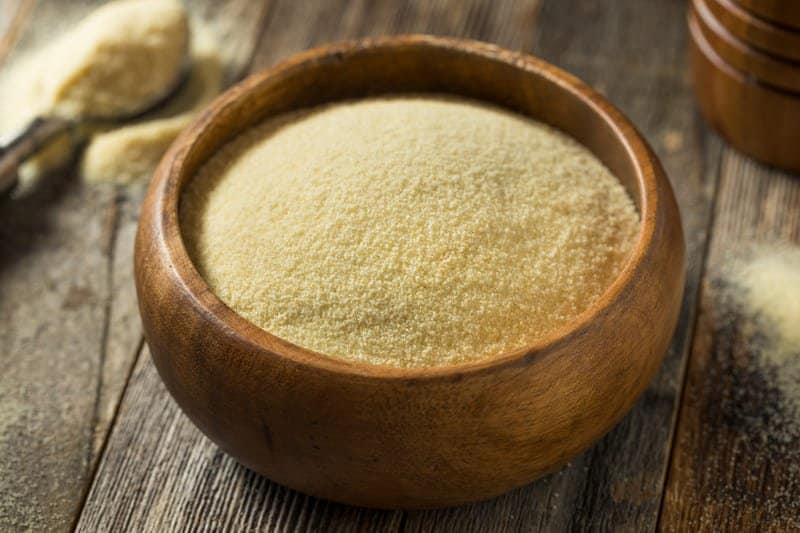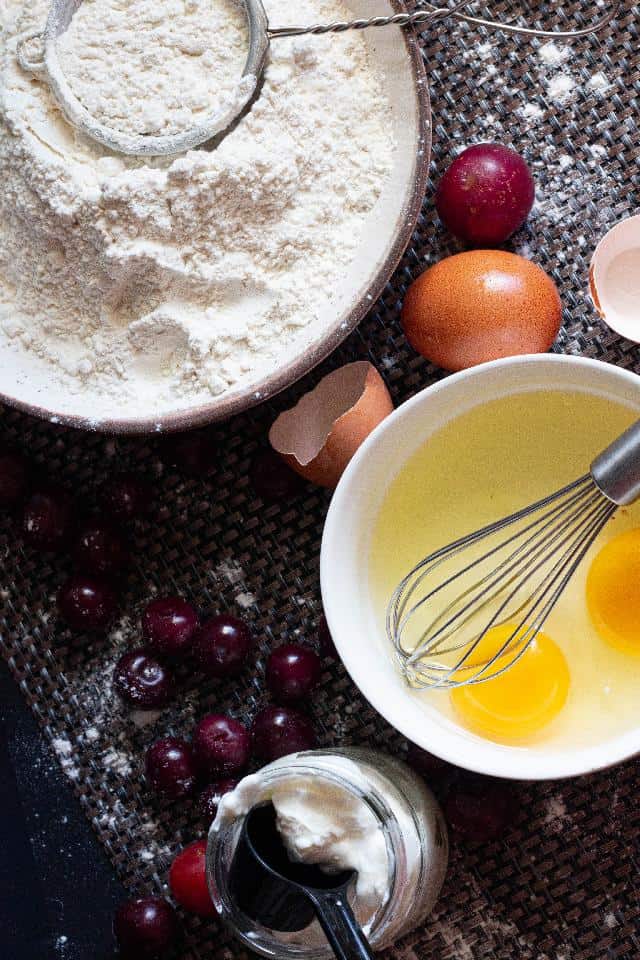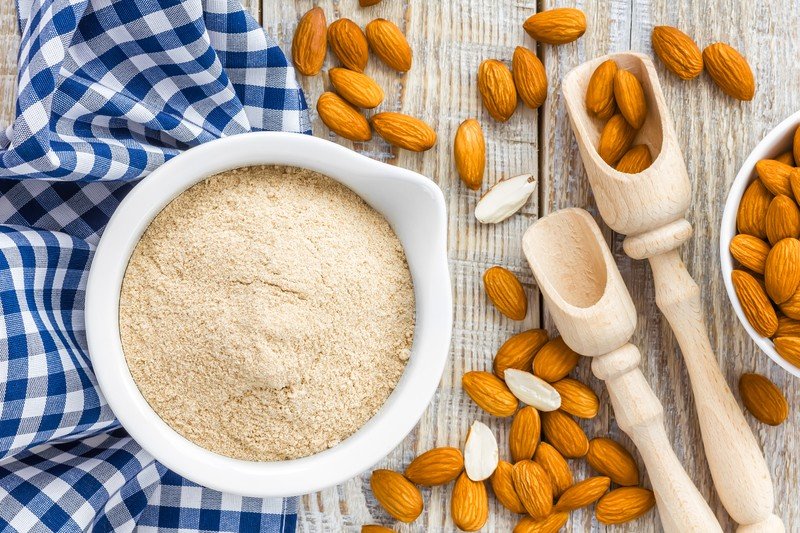Why is Italian bread, pizza and pasta so delicious? One of Italy’s secrets is that Italians use high-quality semolina flour in their flour-based dishes. No wonder every bite is unforgettable. The taste is just incomparable!
The best substitutes for semolina flour are all-purpose flour, pastry flour, bread flour, whole wheat flour, whole spelt flour, rye flour, rye meal, almond flour, rice flour, and high gluten flour.
Semolina Flour Substitutes
Here’s why these 10 different flours can be excellent substitutes for semolina flour in your dish.
1. All-Purpose Flour
The most basic substitute and also the easiest to find in the grocery store is all-purpose flour. There’s a ton of choices, from many different brands. I personally like using this flour when making egg pasta. It’s easy to handle when kneading and it goes well with the rest of the ingredients. When substituting, just follow the 1:1 ratio.
2. Pastry Flour
If you like baking bread at home using semolina flour, how about you try pastry flour as a substitute. Although it’s lower in gluten content compared to semolina, it’s good to use when making soft baked dishes such as cupcakes, muffins and cookies.
If you like your bread more airy and fluffy, you can switch to pastry flour as it improves the texture and overall feel of the dough. When substituting, just use 1½ cups of pastry flour for every cup of semolina flour.
3. Bread Flour
Although its name suggests that this flour is solely for making bread, you can actually use bread flour with almost any pastries and baked dishes. This flour is perfect for making pizzas, focaccias and even pasta. Its high gluten content adds a more mealy bite to the dough once it’s cooked.
Bread flour is quite similar to semolina, since both come from whole wheat. The huge difference between the two is that bread flour is more grainy compared to semolina flour which is just a little coarse in texture. For substituting it in your recipe, just follow the 1:1 ratio which is 1 cup of bread flour over 1 cup of semolina flour.
4. Whole Wheat Flour
One of the favorite flours for pastry chefs is whole wheat flour. It’s pretty much the mother of all flours when you think about it. This flour is one of the most versatile variants that you can choose from, and it works with pretty much anything that you’re trying to make.
From bread to pastries, pasta to pizzas, and even desserts, it’s a no-fail game. I personally like using this for making bread since the aroma is pleasing, it has a nutty taste and a denser texture. For 1 cup of semolina, use 1 cup of whole wheat flour.
5. Whole Spelt Flour
Whole spelt flour is produced from whole spelt grains. It might not be the most popular flour for some, but spelt flour is excellent for baking bread and other dishes. I personally like using this because of the aroma and taste. It’s also rich in fiber and even has fewer carbs compared to other flours.
So if you’re trying to reduce your carb intake but can’t bring yourself to give up bread and pastries, switch it up with whole spelt flour. For substitution, just use 1½ cups of spelt flour over 1 cup of semolina flour.
6. Rye Flour
If you’re all about bread and bread rolls, rye flour is actually the best flour to use. We all know that semolina adds that wonderful flavor and texture, but rye flour can also do the same. Its color is on the darker side but the taste brings a more distinct sour flavor that is perfect for making sourdough bread.
It wins some extra points for its nutritional value because it’s packed with vitamins B and E, and has a lower gluten content. You can use the 1:1 ratio when substituting it in your recipes.
7. Rye Meal
If you prefer the purest form of rye instead, you can opt for rye meal. It’s basically the same as rye flour, however rye meal has retained its bran and germ. Compared to rye flour, rye meal is on the heavier side, and therefore creates much denser bread.
This choice is perfect when you like dense, filling bread. The taste of course is similar to regular rye flour – quite sour and nutty.
8. Almond Flour
If the reason why you can’t have semolina flour is because of gluten, then here’s a gluten-free choice for you. When making delicious dishes, try opting for almond flour instead. It works like magic without having to deal with gluten, extra carbs, and higher calories.
Whether you’re staying away from gluten or just trying to maintain a healthier diet, almond flour is a good choice. The substitution is simple, just follow the 1:1 ratio.
9. Rice Flour
I really like using semolina flour when I make homemade egg pasta. But did you know that rice flour will do just as well? In Asian countries, rice flour is widely used for making noodles. If you like a thicker and stickier pasta, opt for rice flour instead.
It’s simple to make at home and the results are rewarding and really worth the effort. Plus, you don’t need eggs to make noodles. Just water, salt, and rice flour.
10. High Gluten Flour
You’ll find this in most grocery stores. Apparently, high gluten flour is a mixture of different types of flour like oatmeal flour, buckwheat flour, whole wheat flour, rice flour, and all-purpose flour.
You’ll find this in most grocery stores. Apparently, high gluten flour is a mixture of different types of flour like oatmeal flour, buckwheat flour, whole wheat flour, rice flour, and all-purpose flour.
It’s preferred by bakers who want to bake chewy but moist bread (for example our favorite, bagels). You can find tons of variants in the grocery store, ranging from low to higher gluten content.. You can find tons of variants in the grocery store, ranging from low to higher gluten content.
FAQs
What is semolina flour made of?
Semolina flour basically comes from a certain grain called durum wheat. In Italy and most parts of Europe, this type of flour is widely used for creating delicious bread, pasta, and pastries.
Is semolina flour the healthiest?
It’s one of the healthiest flours you can find. This flour is not only packed with flavor but also with great health benefits. It’s high in fiber, which aids digestion and is good for flushing out toxins. It’s also packed with protein and B vitamins that can help you maintain a healthy weight or maybe even shed some extra pounds.
Can I substitute cornflour with semolina?
That depends on the recipe that you’re making. If you’re making cornbread, you would still need to add the corn flavor to achieve the purpose of the recipe. But if it’s just for other baked dishes, semolina flour is a good substitute (especially for bread and other pastries).
Is semolina flour keto-friendly?
Although it’s packed with vitamins and nutrients, semolina flour is also packed with carbohydrates, which means it is not good for the keto diet. The keto diet is mostly focused on protein-rich foods. So adding semolina flour to your everyday meals might not be a good idea.
Is semolina flour gluten-free?
Unfortunately, no. Semolina flour comes from durum wheat which is packed with gluten. Because of its density it’s excellent to use with bread, pasta, and couscous. If you’re looking to cut gluten from your diet, try to look for other substitutes, such as almond flour.
Semolina flour is one of the best, most versatile flours that can be used for almost any recipe. But always remember that there’s a ton of flour choices out there waiting to be experimented with. As long as it doesn’t compromise taste, quality, and texture, substituting it with other flours shouldn’t be a problem.









2 comments
Thank you, found this so helpful, my son has a gluten intolerance so, will be trying the rice and almond flour
Saurabh, Thank You Sir. I Do Appreciate the education & Now Understand the Differences in these Flours.